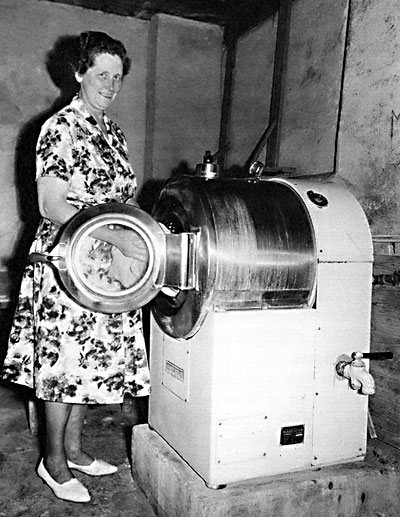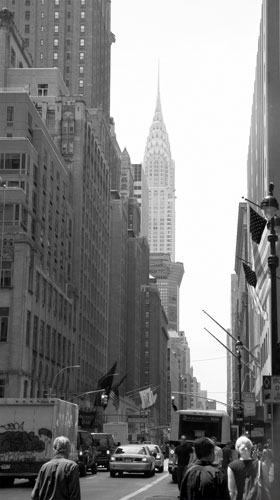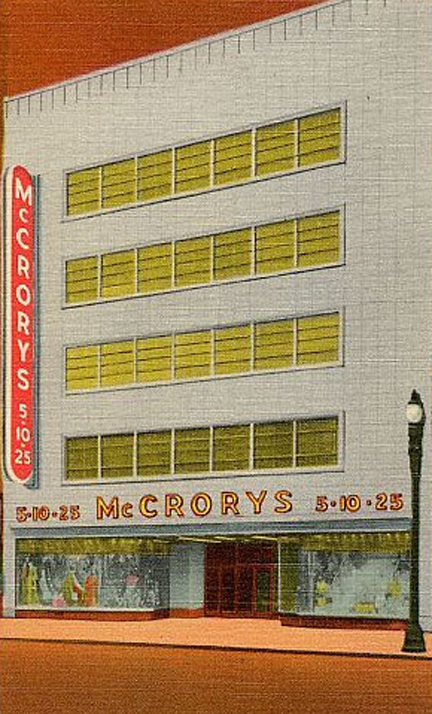|
E.J. Korvettes
E. J. Korvette, also known as Korvettes, was an American chain of discount department stores, founded in 1948 in New York City. It was one of the first department stores to challenge the suggested retail price provisions of anti-discounting statutes. Founded by World War II veteran Eugene Ferkauf and his friend, Joe Zwillenberg, E. J. Korvette did much to define the idea of a discount department store. It displaced earlier five and dime retailers and preceded later discount stores, like Walmart, and warehouse clubs such as Costco. The company failed to properly manage its business success, which led to decline and its 1980 bankruptcy and closure. Innovations E.J. Korvette's founder, Eugene Ferkauf, began his discounting career in a loft in mid-Manhattan, New York City. Inventory consisted of well-known brands of luggage, household appliances, and some jewelry. Discounts were one-third off regular prices. Sales were more than $2,500 per square foot. Ferkauf retired in 1968. ... [...More Info...] [...Related Items...] OR: [Wikipedia] [Google] [Baidu] |
Discount Department Store
A discount store or discounter offers a retail format in which products are sold at prices that are in principle lower than an actual or supposed "full retail price". Discounters rely on bulk purchasing and efficient Logistics, distribution to keep down costs. Types (United States) Discount stores in the United States may be classified into different types: Hypermarkets (superstores) Discount superstores such as Walmart or Target Corporation, Target sell general merchandise in a big-box store; many have a full grocery selection and are thus hypermarkets, though that term is not generally used in North America. In the 1960s and 1970s the term "discount department store" was used, and chains such as Kmart (United States), Kmart, Zodys and TG&Y billed themselves as such. The term "discount department store" or "off-price department store" is sometimes applied to big-box discount retailers of apparel and home goods, such as Ross Dress For Less, Marshalls, TJ Maxx, and Kohls. Categor ... [...More Info...] [...Related Items...] OR: [Wikipedia] [Google] [Baidu] |
Home Appliance
A home appliance, also referred to as a domestic appliance, an electric appliance or a household appliance, is a machine which assists in household functions such as cooking, cleaning and food preservation. Appliances are divided into three types: small appliances, major appliances (also known as white goods) and consumer electronics (brown goods). Definition Given a broad usage, the domestic application attached to home appliance is tied to the definition of appliance as "an instrument or device designed for a particular use or function". More specifically, Collins English Dictionary defines "home appliance" as: "devices or machines, usually electrical, that are in your home and which you use to do jobs such as cleaning or cooking". The broad usage, afforded to the definition allows for nearly any device intended for domestic use to be a home appliance, including consumer electronics as well as stoves, refrigerators, toasters and air conditioners. History While many ap ... [...More Info...] [...Related Items...] OR: [Wikipedia] [Google] [Baidu] |
Lexington Avenue (Manhattan)
Lexington Avenue, often colloquially abbreviated as "Lex", is an avenue on the East Side of the borough of Manhattan in New York City that carries southbound one-way traffic from East 131st Street to Gramercy Park at East 21st Street. Along its , 110-block route, Lexington Avenue runs through Harlem, Carnegie Hill, the Upper East Side, Midtown, and Murray Hill to a point of origin that is centered on Gramercy Park. South of Gramercy Park, the axis continues as Irving Place from 20th Street to East 14th Street. Lexington Avenue was not one of the streets included in the Commissioners' Plan of 1811 street grid, so the addresses for cross streets do not start at an even hundred number, as they do with avenues that were originally part of the plan. History Both Lexington Avenue and Irving Place began in 1832 when Samuel Ruggles, a lawyer and real-estate developer, petitioned the New York State Legislature to approve the creation of a new north–south avenue between the existi ... [...More Info...] [...Related Items...] OR: [Wikipedia] [Google] [Baidu] |
Third Avenue
Third Avenue is a north-south thoroughfare on the East Side of the New York City borough of Manhattan, as well as in the center portion of the Bronx. Its southern end is at Astor Place and St. Mark's Place. It transitions into Cooper Square, and further south, the Bowery, Chatham Square, and Park Row. The Manhattan side ends at East 128th Street. Third Avenue is two-way from Cooper Square to 24th Street, but since July 17, 1960 has carried only northbound (uptown) traffic while in Manhattan above 24th Street; in the Bronx, it is again two-way. However, the Third Avenue Bridge carries vehicular traffic in the opposite direction, allowing only southbound vehicular traffic, rendering the avenue essentially non-continuous to motor vehicles between the boroughs. The street leaves Manhattan and continues into the Bronx across the Harlem River over the Third Avenue Bridge north of East 129th Street to East Fordham Road at Fordham Center, where it intersects with U.S. 1. I ... [...More Info...] [...Related Items...] OR: [Wikipedia] [Google] [Baidu] |
Fair Trade Law
A fair trade law was a statute in any of various states of the United States that permitted manufacturers the right to specify the minimum retail price of a commodity, a practice known as "price maintenance". Such laws first appeared in 1931 during the Great Depression in the state of California. They were ostensibly intended to protect small businesses to some degree from competition from very large chain stores during a time when small businesses were suffering. Many people objected to this on the grounds that if the manufacturers could set the price, consumers would have to pay more even at large discount stores. The complexity of the market also made the enforcement of these laws almost impractical. As the chain stores became more popular, and bargain prices more common, there was a widespread repeal of the laws in many jurisdictions. By 1975, the laws had been repealed completely See also * Resale price maintenance Resale price maintenance (RPM) or, occasionally, retai ... [...More Info...] [...Related Items...] OR: [Wikipedia] [Google] [Baidu] |
Gimbels
Gimbel Brothers (known simply as Gimbels) was an American department store corporation that operated for over a century, from 1842 until 1987. Gimbel patriarch Adam Gimbel opened his first store in Vincennes, Indiana, in 1842. In 1887, the company moved its operations to the Gimbel Brothers Department Store in Milwaukee, Wisconsin. It became a chain when it opened a second, larger store in Philadelphia, Pennsylvania, in 1894, moving its headquarters there. At the urging of future company president Bernard Gimbel, grandson of the founder, the company expanded to New York City in 1910. The company is known for creating the oldest Thanksgiving parade, the Gimbels Thanksgiving Day Parade, originating in 1920 in Philadelphia. Gimbels was also considered the chief rival of Macy's with their feud popularized in American culture. As of 1930, Gimbels had grown to 20 stores, whose sales revenue made it the largest department store chain in the world. The company expanded to a peak of 53 s ... [...More Info...] [...Related Items...] OR: [Wikipedia] [Google] [Baidu] |
Macy's
Macy's (originally R. H. Macy & Co.) is an American chain of high-end department stores founded in 1858 by Rowland Hussey Macy. It became a division of the Cincinnati-based Federated Department Stores in 1994, through which it is affiliated with the Bloomingdale's department store chain; the holding company was renamed Macy's, Inc. in 2007. As of 2015, Macy's was the largest U.S. department store company by retail sales. Macy's as of October 29, 2022, has 510 stores (569 boxes), inclusive of 445 department stores (499 boxes; includes 51 stores or 55 boxes that are neighborhood stores), 46 furniture galleries (51 boxes), 1 furniture clearance center, 9 freestanding Backstage stores, 7 Market by Macy's and 2 stores converted to fulfillment centers (there are a total of 506 full line stores and a total of 551 stores) with the Macy's nameplate in operation throughout the United States. Its flagship store is located at Herald Square in the New York City borough of Manhattan. The com ... [...More Info...] [...Related Items...] OR: [Wikipedia] [Google] [Baidu] |
McCrory's
McCrory Stores or J.G. McCrory's was a chain of five and dime stores in the United States based in York, Pennsylvania. The stores typically sold shoes, clothing, housewares, fabrics, penny candy, toys, cosmetics, and often included a lunch counter or snack bar. They also exclusively sold Oriole Records, one of the most popular ' dime store labels' from 1921 to 1938. Founding John Graham McCrorey (1860-1923) opened his first store in Scottdale, Pennsylvania, in 1882. By 1885, the chain had five stores in Pennsylvania. McCrory was known for his thrifty nature, so much so that he legally dropped the ''e'' from his last name so he would not have to pay for extra letters on his store signs. One of the firm's policies was to acquire locations whenever property could be found at a reasonable purchase price. In November 1925, approximately ⅔ of its stores were leased, with the remainder owned by a subsidiary, the McCrory Realty Corporation. The retailer's gross sales approached ... [...More Info...] [...Related Items...] OR: [Wikipedia] [Google] [Baidu] |
Central Business District
A central business district (CBD) is the commercial and business centre of a city. It contains commercial space and offices, and in larger cities will often be described as a financial district. Geographically, it often coincides with the "city centre" or "downtown". However, these concepts are not necessarily synonymous: many cities have a central ''business'' district located away from its commercial and or cultural centre and or downtown/city centre, and there may be multiple CBDs within a single urban area. The CBD will often be characterised by a high degree of accessibility as well as a large variety and concentration of specialised goods and services compared to other parts of the city. For instance, Midtown Manhattan, New York City, is the largest central business district in the city and in the United States. London's city centre is usually regarded as encompassing the historic City of London and the medieval City of Westminster, while the City of London and the transform ... [...More Info...] [...Related Items...] OR: [Wikipedia] [Google] [Baidu] |
Suburban
A suburb (more broadly suburban area) is an area within a metropolitan area, which may include commercial and mixed-use, that is primarily a residential area. A suburb can exist either as part of a larger city/urban area or as a separate political entity. The name describes an area which is not as densely populated as an inner city, yet more densely populated than a rural area in the countryside. In many metropolitan areas, suburbs exist as separate residential communities within commuting distance of a city (cf "bedroom suburb".) Suburbs can have their own political or legal jurisdiction, especially in the United States, but this is not always the case, especially in the United Kingdom, where most suburbs are located within the administrative boundaries of cities. In most English-speaking countries, suburban areas are defined in contrast to central or inner city areas, but in Australian English and South African English, ''suburb'' has become largely synonymous with what ... [...More Info...] [...Related Items...] OR: [Wikipedia] [Google] [Baidu] |




.jpg)

.jpg)
